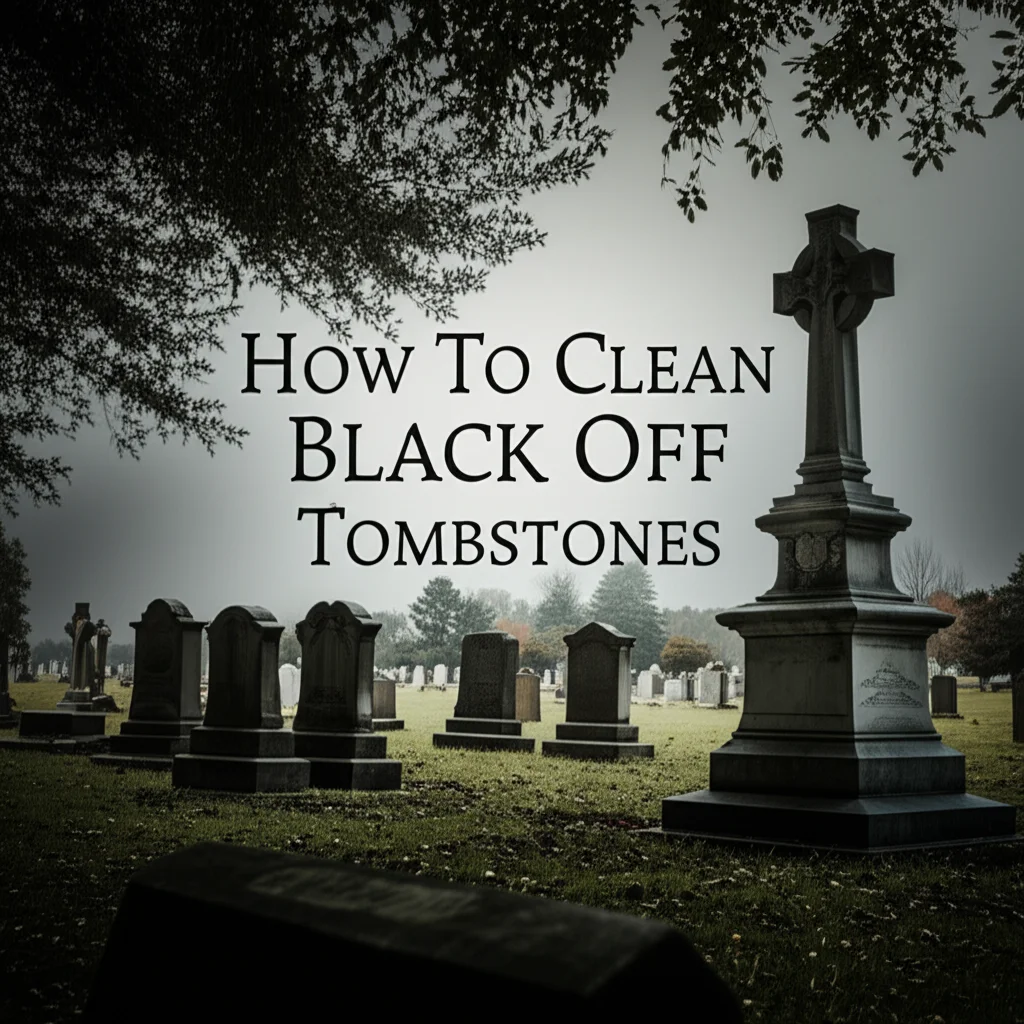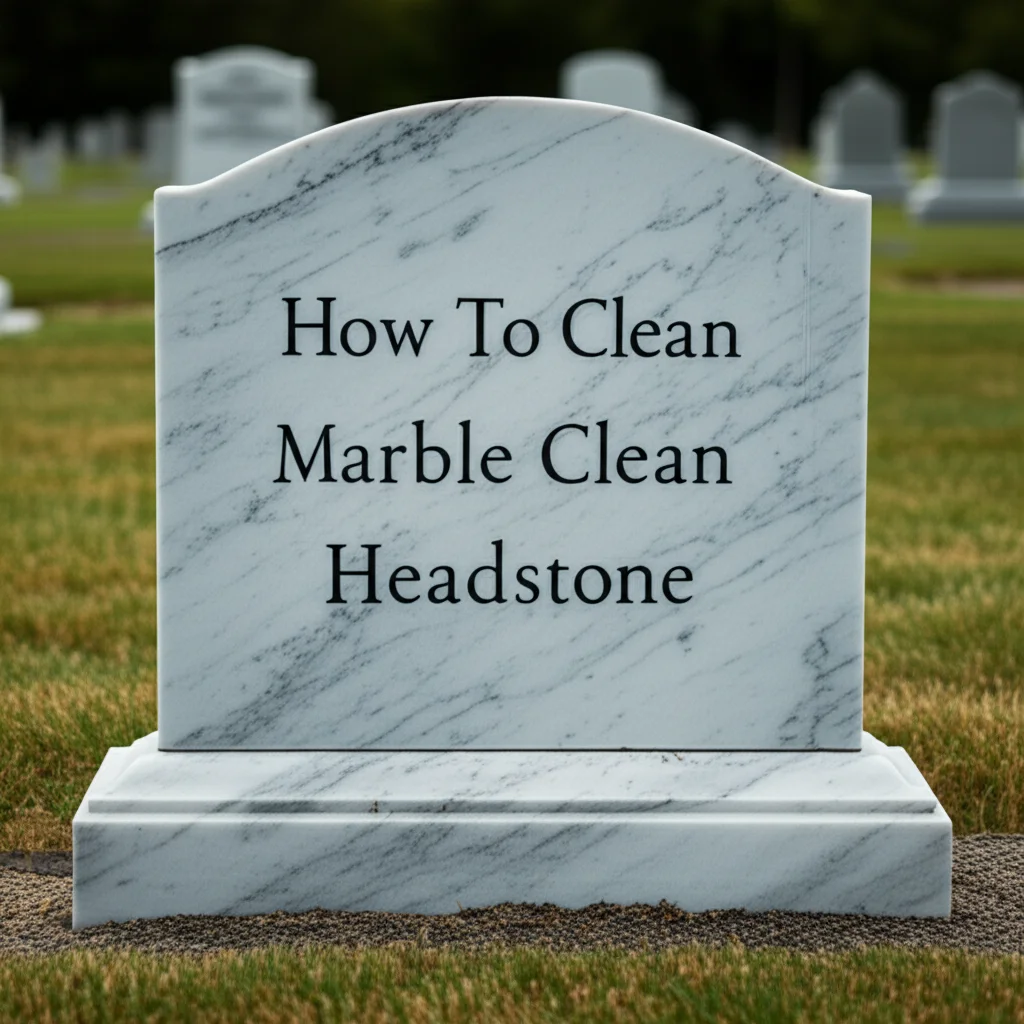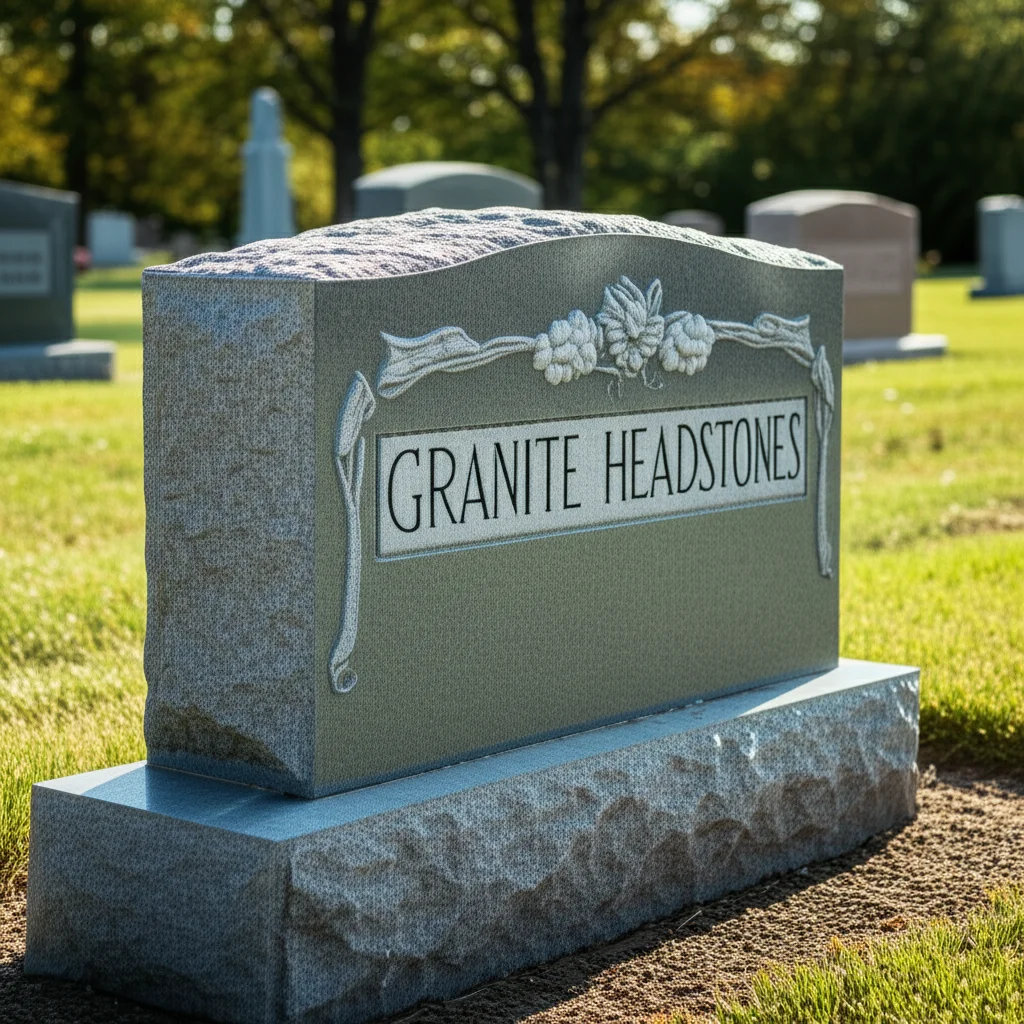· Todd Martin · Outdoor Cleaning · 18 min read
How To Clean Old Tombstones

Restore Dignity: How to Clean Old Tombstones Safely
Cemeteries hold silent stories. These stone markers stand as enduring tributes to lives once lived. Over time, nature takes its toll on these important memorials. Lichen, moss, dirt, and pollution obscure inscriptions and erode the stone.
Learning how to clean old tombstones correctly is a respectful act. It brings dignity back to these markers. Improper cleaning can cause irreversible damage. This guide will walk you through the proper steps. We will cover necessary tools, safe methods, and what to avoid. You will learn to clean these memorials effectively while preserving their historical value.
Takeaway
- Always get permission before cleaning any tombstone.
- Use only clean water and approved non-ionic stone cleaners.
- Employ soft brushes, never wire brushes or harsh tools.
- Rinse thoroughly and avoid pressure washing.
- Clean gently and patiently to prevent damage.
Cleaning old tombstones involves careful steps. You will use soft brushes, plain water, and specific non-ionic stone cleaners. Always rinse the stone thoroughly. This method removes biological growth and dirt without harming the delicate surface.
Understanding Tombstone Materials and Their Vulnerabilities
Before you clean old tombstones, know what they are made of. Different stone types react differently to cleaning agents. Most old tombstones are granite, marble, limestone, or sandstone. Each material has unique properties. Knowing these helps you clean without causing damage.
Common Stone Types
Granite is a very hard and durable stone. It resists weathering well. Granite tombstones can tolerate more scrubbing. They are less porous than other stones. Lichen and moss still grow on them. Black stains are also common on granite.
Marble is a softer, more porous stone. It is a metamorphic rock. Marble is mostly calcium carbonate. This makes it vulnerable to acidic cleaners. Even mild acids can etch marble surfaces. Acids also dissolve the stone over time. Limestone is a sedimentary rock. It is similar to marble in composition. Limestone is also very soft and easily damaged by acids.
Sandstone is a sedimentary rock made from sand grains. Its porosity varies greatly. Some sandstone is very soft and crumbles easily. Other types are quite hard. You must be extremely gentle with sandstone. It can be very fragile. Using the wrong technique can cause grains to detach.
Risks of Improper Cleaning
Improper cleaning causes lasting damage. Harsh chemicals, like bleach or household cleaners, react badly with stone. They can pit, stain, or dissolve the stone surface. Bleach, for example, can break down the stone’s integrity. It can also leave behind a whitish residue. This residue may promote future biological growth.
High-pressure washing is also very dangerous. The force of the water can strip away the stone’s surface. It can dislodge fragile pieces. This is especially true for marble, limestone, and sandstone. Wire brushes or metal tools scratch the stone. They create microscopic grooves. These grooves trap water and promote more growth. This speeds up deterioration. Always use the gentlest methods available. Your goal is preservation, not just immediate cleanliness.
Essential Tools and Supplies for Safe Tombstone Cleaning
Having the right tools is crucial when you plan to clean old tombstones. Using inappropriate items can damage the memorial. You want to remove grime without harming the stone itself. I always pack a specific set of supplies. This ensures the job is done safely and effectively.
First, you need a good supply of clean, fresh water. Distilled water is ideal, but tap water is usually fine. Bring several large buckets for rinsing. A separate bucket for mixing cleaner is also useful. Water helps loosen dirt and rinse away cleaning solutions. It also keeps the stone wet during the process. This prevents cleaners from drying too quickly.
You will need a variety of brushes. Only use non-metal brushes. Natural bristle brushes are good. Soft nylon or synthetic brushes also work well. A soft-bristled scrub brush is essential for general cleaning. Small detail brushes, like toothbrushes, help with intricate carvings. Avoid stiff brushes, as they can scratch the stone. Never use wire brushes.
Approved Cleaning Solutions
The most important supply is a non-ionic stone cleaner. These cleaners do not leave behind electrically charged residues. Such residues can attract dirt or promote new biological growth. D/2 Biological Solution is a widely recommended non-ionic cleaner. It is effective against mold, mildew, lichen, and algae. It is safe for all types of stone. Many professional conservators use it. You can find it online or at specialty stone supply stores. Avoid any cleaner with acids, phosphates, or strong bases. These chemicals will harm the stone.
For stubborn black stains, a biological cleaner that specifically targets these can be used. These often contain enzymes that break down the organic matter. Always ensure they are non-ionic and safe for historic stone. Sometimes, plain water and a good scrub are enough. I always start with just water. I only add cleaner if dirt persists.
Gentle Brushes and Tools
Beyond brushes and cleaner, consider other useful items. A plastic or wooden scraper can gently remove thick moss or lichen. Never use metal scrapers. Gloves are important to protect your hands from the cleaner and dirt. Safety glasses protect your eyes from splashes. A soft cloth or sponge can help apply cleaner. They are also good for drying delicate areas.
Bring kneelers or a small portable stool. This helps with comfort during the cleaning process. It also lets you work more steadily. Having a spray bottle can be useful for spot treatments. It lets you apply cleaner to specific areas. Remember, patience is your most valuable tool. Take your time with each step.
Preparation: Assessing the Tombstone and Area
Before you clean old tombstones, proper preparation is key. This stage ensures safety and effectiveness. It also prevents any unintended damage. I always begin with a thorough assessment. This includes checking the stone’s condition and the surrounding area.
First, you must obtain permission. Cleaning any tombstone usually requires permission. Contact the cemetery office or local historical society. Explain your intentions clearly. They can provide specific guidelines or rules. They may also tell you about any existing damage or historical significance. Cleaning a stone without permission can lead to serious problems. It might even be illegal. Always confirm ownership or stewardship before touching any memorial.
Permission and Ethics
Cemeteries have rules. These rules protect both the monuments and the property. Some cemeteries have specific approved cleaning methods. They might only allow certain products. Ignoring these rules can cause issues. It shows disrespect to the family and the cemetery staff. I always ensure I have written permission if possible. This way, everyone is clear on the plan. This step is about ethics and respect for the deceased and their families.
Once you have permission, inspect the tombstone itself. Look for any existing damage. Cracks, chips, or crumbling sections need special care. These areas are very fragile. Aggressive cleaning can worsen existing damage. If the stone is extremely fragile, do not clean it yourself. Professional conservators handle these cases. Take photos of the tombstone before you start cleaning. These photos provide a record of its condition. They also show the progress you make.
Site Preparation
Clear the area around the tombstone. Remove any loose leaves, twigs, or debris. This helps you work safely. It also prevents new dirt from getting onto the cleaned stone. Some people bring a soft broom for this. Be gentle when clearing. You do not want to disturb any nearby plantings. Avoid using metal rakes. They can scratch the stone or surrounding markers.
Gather all your tools and supplies. Place them within easy reach. Set up your buckets of water. Ensure you have enough water for the entire process. Plan to clean on a cloudy day. Direct sunlight can cause cleaners to dry too quickly. This leaves streaks or residues. It also makes the cleaning solution less effective. If a cloudy day is not possible, work early in the morning or late in the afternoon. These times offer cooler temperatures and less direct sun. Take your time with these preparation steps. They lay the groundwork for a successful and safe cleaning.
Step-by-Step Guide to Gently Clean Old Tombstones
Learning how to clean old tombstones properly requires a gentle approach. Follow these steps for effective and safe cleaning. Patience is key. You want to remove grime without harming the stone. I always take my time through each stage.
Initial Rinse and Wetting
Start by thoroughly wetting the entire tombstone. Use plain water. You can use a spray bottle or pour water directly from a bucket. Make sure the stone is saturated. This step helps loosen surface dirt. It also prevents the cleaning solution from soaking too deeply into the stone. Keep the stone wet throughout the entire cleaning process. Do not let it dry out. This is very important, especially for porous stones like marble.
Once the stone is wet, gently remove any loose debris. Use your soft-bristled brush. Brush away surface dirt, leaves, and cobwebs. Be very light with your strokes. Your goal here is only to remove loose material. Avoid aggressive scrubbing at this stage.
Applying and Scrubbing
Now it’s time to apply your chosen non-ionic stone cleaner. D/2 Biological Solution is an excellent choice. Follow the product’s instructions for mixing. Often, you can use it undiluted for heavy growth. For lighter cleaning, dilute it with water. Apply the cleaner evenly over the wet stone. You can use a spray bottle for this. A soft sponge or cloth also works well. Ensure the entire surface you plan to clean is covered.
Let the cleaner sit for a few minutes. This allows it to penetrate the biological growth. Then, begin gently scrubbing with your soft-bristled brush. Work in small sections. Use light, circular motions. Do not apply too much pressure. The cleaner is doing most of the work. The brush helps lift the loosened grime. For stubborn black spots, sometimes referred to as ‘black bio-growth’ or ‘black mold’, you might need to apply a bit more cleaner and let it dwell longer. For detailed guidance on these specific issues, refer to our article on how to clean black off tombstones. If the brush feels too stiff, switch to a softer one. You want to see the dirt lift away.
Final Rinsing
After scrubbing, rinse the stone thoroughly with clean water. Use plenty of water. You want to remove all traces of the cleaner and loosened dirt. Start from the top of the stone and work your way down. Ensure all cleaner residue washes away. Leftover cleaner can attract new dirt. It can also cause staining over time. Repeat the scrubbing and rinsing steps if necessary. Some very old tombstones with heavy growth may need multiple applications.
Do not expect immediate perfect results, especially with biological cleaners like D/2. These cleaners continue to work over weeks or months. The full effect may not be visible for some time. The cleaner penetrates the stone. It breaks down the biological growth over time. You may return later to see even better results. Always let the stone air dry naturally after the final rinse. Do not use towels. This final air drying allows any remaining cleaner to continue its work. It also prevents transferring lint to the stone surface.
Tackling Common Stains: Moss, Lichen, and Biological Growth
When you clean old tombstones, you will encounter various types of biological growth. Moss, algae, and lichen are common culprits. These organisms thrive in damp, shaded environments. They can obscure inscriptions and trap moisture. This speeds up stone deterioration. Removing them requires specific techniques.
Removing Moss and Algae
Moss and algae often form a green, fuzzy layer. They are usually easier to remove than lichen. Start by wetting the entire stone thoroughly with water. This softens the moss and algae. Then, apply a non-ionic stone cleaner. Follow the product’s instructions for dilution. For heavy growth, use the cleaner undiluted.
Let the cleaner sit on the surface for about 10-15 minutes. This allows it to penetrate the growth. Use a soft-bristled brush to gently scrub the affected areas. Use light, circular motions. The moss and algae should lift off fairly easily. Rinse the stone thoroughly with clean water. Ensure all residue is gone. You may need to repeat this process for very thick layers.
Cleaning Stubborn Lichen
Lichen is a combination of fungus and algae. It forms hard, crusty patches on stone surfaces. Lichen is often gray, green, orange, or black. It adheres strongly to the stone. Removing lichen is the most challenging part of cleaning tombstones. Do not try to scrape it off with metal tools. This will damage the stone. For targeted advice on this, our guide on how to clean lichen off granite tombstones offers in-depth steps.
The best method for lichen is a prolonged application of a non-ionic biological cleaner. Spray the cleaner directly onto the dry lichen patches. Let it soak in for an extended period. Some conservators recommend keeping the lichen wet with the cleaner for hours. You can even cover the treated area with a damp cloth or plastic wrap. This prevents the cleaner from drying out. After several hours, or even overnight, the lichen should have softened. Then, gently scrub it with a soft brush. It might still require considerable effort. Rinse very well. For particularly tough stains on stone or concrete, general methods for how to clean stains from concrete can offer supplementary insights into stain removal.
Addressing Black Stains
Black stains on tombstones are often a type of black mold or algae. They can also be from pollutants. These stains can be very stubborn. They embed themselves into the stone’s pores. Again, a non-ionic biological cleaner is your best option. Apply the cleaner directly to the black areas. Let it sit for a longer period, perhaps 30 minutes to an hour.
Gently scrub with a soft brush. You might need to repeat the application and scrubbing process multiple times. Do not increase the pressure. Just let the cleaner do its job. For general biological growths that resemble mold on various surfaces, tips from articles like how to clean mold off concrete can be helpful. Remember that the full effect of these cleaners takes time. The black stains may fade over weeks or even months as the biological growth dies off and washes away with rain. Persistence and patience are vital for tackling these tough stains.
Important Precautions and What to Avoid When Cleaning Gravestones
When you clean old tombstones, knowing what not to do is as important as knowing what to do. Many common cleaning practices can cause irreversible damage to historic stone. Always prioritize preservation over aggressive cleaning. My rule is: if in doubt, don’t do it.
Harmful Cleaning Agents
Never use household cleaning products. Bleach, dish soap, laundry detergent, and acid-based cleaners are extremely harmful. Bleach, even diluted, can react with the stone’s minerals. It can cause etching, discoloration, and long-term damage. It can also leave a residue that encourages new biological growth. Dish soap and laundry detergent often contain salts and other chemicals. These can leave behind residues that attract dirt. They also promote the growth of new organisms. Acids, even weak ones like vinegar, are very dangerous for marble, limestone, and sandstone. They dissolve the stone’s surface. This leads to etching and loss of detail. Even on granite, acids can remove polish and cause dullness over time. Stick to approved non-ionic stone cleaners only.
Ammonia-based cleaners are also highly corrosive. They can damage stone and engravings. Abrasive cleaners, like scouring powders, scratch the surface. They create micro-fissures. These fissures trap moisture and dirt. This speeds up stone decay. Avoid any product not specifically designed and recommended for historic stone monuments.
Damaging Techniques
High-pressure washers, also known as power washers, are absolutely forbidden. The intense force of the water will erode the stone surface. It can blast away delicate carvings. It can also dislodge fragile pieces of stone. Even on hard granite, pressure washing can remove the polished finish. It can drive water deep into cracks. This leads to freeze-thaw damage in colder climates. Always use gentle hand scrubbing.
Do not use metal tools or wire brushes. Wire brushes leave metal particles embedded in the stone. These particles can rust. They cause staining and further damage. Metal scrapers can scratch and gouge the stone. Only use soft, non-metallic brushes. Plastic or wooden scrapers can carefully remove very thick, loose growth. Be extremely gentle with any scraping tool.
Avoid excessive scrubbing, even with soft brushes. If the dirt is not coming off easily, you need more dwell time for your cleaner. Do not increase pressure. Let the biological cleaner work its magic over time. Over-scrubbing can still cause wear and tear on the stone surface. Also, never use sandblasting or chemical strippers. These industrial methods are too harsh for historic stone. They cause permanent damage. Always prioritize the stone’s longevity over its immediate appearance.
Maintaining Cleanliness and Long-Term Tombstone Care
Cleaning an old tombstone is an act of care. But the work doesn’t stop after the initial cleaning. Understanding how to maintain cleanliness and providing long-term care helps preserve these memorials for future generations. Regular monitoring and gentle follow-up are important.
Regular Monitoring
After the initial deep clean, I recommend visiting the tombstone periodically. A yearly check-up is a good idea. Look for new biological growth. Catching moss, algae, or lichen early makes future cleaning much easier. Small patches can be addressed with a quick spray of non-ionic cleaner and a gentle rinse. This prevents heavy build-up from occurring again.
Consider the environment around the tombstone. Trees or shrubs casting heavy shade can promote growth. Overhanging branches might drip sap or create excessive moisture. While you cannot always alter the environment, awareness helps. If a stone is constantly wet, growth will return faster. You might adjust your cleaning frequency based on these factors.
When to Call a Professional
Sometimes, a tombstone needs more than a simple cleaning. If the stone has severe cracks, large chips, or has completely toppled over, do not attempt repairs yourself. These situations require professional conservation expertise. Historic stone conservators have specialized knowledge. They can stabilize fragile stones. They can also repair damage without causing further harm. Attempting amateur repairs can worsen the problem. It can also reduce the historical integrity of the monument.
If you encounter very unique or historically significant tombstones, consult a professional. They can advise on the best approach for preservation. They may have specific treatments for rare stone types or unusual damage. Their expertise ensures the monument’s longevity.
Finally, remember that ongoing care is a commitment. It is a slow, gentle process. You are working with historical artifacts. Each cleaning effort contributes to their preservation. By consistently applying safe cleaning methods and regular monitoring, you help these old tombstones stand tall. They will continue to tell their stories for many more years to come. Your careful actions ensure that the memories inscribed on them remain visible and honored.
FAQ Section
Can I use bleach to clean tombstones?
No, never use bleach to clean tombstones. Bleach contains harsh chemicals that can severely damage stone. It can react with minerals in the stone, leading to etching, discoloration, and accelerated deterioration. Bleach also leaves residues that might encourage more biological growth over time. Stick to approved non-ionic stone cleaners designed for monuments.
How often should tombstones be cleaned?
The frequency depends on the environment and stone type. Tombstones in damp, shaded areas might need cleaning every 1-3 years. Those in sunny, dry locations might only need cleaning every 5-10 years. Regular monitoring helps determine the best schedule. Gentle, periodic maintenance prevents heavy build-up.
Is it safe to use a pressure washer on a tombstone?
No, it is never safe to use a pressure washer on a tombstone. The high force of the water can erode the stone surface, remove delicate carvings, and dislodge fragile pieces. Pressure washing can cause irreversible damage. Always use gentle hand scrubbing with soft brushes and low-pressure water.
What if the tombstone is very old or fragile?
If a tombstone is very old, crumbling, or has severe cracks, do not attempt to clean it yourself. Fragile stones are easily damaged by even gentle methods. In such cases, contact a professional historic stone conservator. They have the expertise and specialized tools to stabilize and treat very delicate monuments safely.
Where can I get approved tombstone cleaners?
Approved tombstone cleaners, such as D/2 Biological Solution, are typically available online. You can also find them at specialty stone supply stores, monument companies, or cemetery supply outlets. Ensure the product explicitly states it is safe for historic stone monuments and is non-ionic.
Can I clean any tombstone without permission?
No, you should never clean a tombstone without explicit permission. Always contact the cemetery office, church, or local historical society first. They can provide specific rules, guidelines, and necessary authorizations. Cleaning without permission can be disrespectful and might even lead to legal issues.
Conclusion
Cleaning old tombstones is a profound act of respect. It connects us to the past. By learning how to clean old tombstones correctly, you help preserve these important historical markers. You ensure they remain legible for future generations. This process requires patience, the right tools, and a gentle touch.
Remember to always obtain permission before you begin. Use only clean water and approved non-ionic cleaners. Equip yourself with soft brushes. Avoid any harsh chemicals or abrasive tools. Never use a power washer. These precautions protect the delicate stone. They prevent irreversible damage. Your thoughtful efforts extend the life of these memorials. They honor the memory of those who rest beneath. Go forward with care and reverence.





